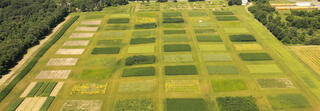Environmental factors and their effect on soil nitrous oxide fluxes in bioenergy crops

Efforts to reduce concentrations of NO3- in the soil may be effective at reducing “hot moments” of N2O production.
The Science
Nitrous oxide (N2O) is a potent greenhouse gas and major component of the net global warming potential of bioenergy crops. Numerous environmental factors influence soil N2O production, making direct correlation difficult to any one factor under field conditions.
The Impact
Conceptualizing N2O production in terms of hot moments, or short periods of high intensity N2O gas efflux, an environmental constraints model provides a useful framework for identifying areas for reducing both the magnitude and variability of N2O production. Understanding how various environmental factors interact with N2O production levels could lead to improved cropping system management.
Summary
To understand the factors that influence soil N2O production in bioenergy crops under field conditions, researchers at the GLBRC employed quantile regression to evaluate the effects of soil temperature, water-filled pore space (WFPS), and concentrations of soil nitrate (NO3-) and ammonium (NH4+) on the upper bounds of soil N2O fluxes. Data was collected over six years from a range of bioenergy crops including no-till grain crops, perennial warm-season grasses, hybrid poplar, and polycultures of tallgrass prairie species each grown with and without fertilizer addition at two sites in the Midwest (Michigan and Wisconsin). Results indicate managing NO3- in the soil, which is accomplished more easily than managing WFPS or soil temperature, may be particularly effective at minimizing the impact of hot moments when other factors are highly conducive to denitrification. Land managers are unlikely to forego nitrogen fertilization altogether, but there may be alternative means to reduce NO3- concentrations, such as the use of enhanced efficiency fertilizers which promote a gradual release of NO3- over time. Additionally, increasing the diversity and perenniality of crops has been shown to reduce the amount of available NO3- and NH4+ which would likely constrain the magnitude of fluxes that could occur even with optimal temperature and moisture.
Program Manager
N. Kent Peters
kent.peters@science.doe.gov, 301-903-5549
Principal Investigator
Randall D. Jackson
rdjackson@wisc.edu
Funding
Funding was provided by the DOE Great Lakes Bioenergy Research Center (DOE BER Office of Science DE‐FC02‐07ER64494) and the DOE OBP Office of Energy Efficiency and Renewable Energy (DE‐AC05‐76RL01830), the NSF LTER Program (DEB 1027253), and Michigan AgBioResearch.
Publications
D. Duncan, et al., “Environmental factors function as constraints on soil nitrous oxide fluxes in bioenergy feedstock cropping systems.” GBC Bioenergy. (2018) [DOI: 10.1111/gcbb.12572]
Related Links
https://onlinelibrary.wiley.com/doi/10.1111/gcbb.12572